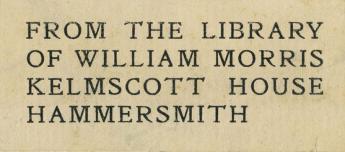The Library of William Morris â A Digital Catalogue by Bill Peterson and Sylvia Holton Peterson

An excellent bibliographical project and an important contribution to Victorian England and the history of the private presses: Bill Peterson and Sylvia Holton Peterson have launched a digital catalogue of the library of William Morris (1834-1896) who was one of the key figures of the Victorian era and founder of the Kelmscott Press in 1891. So far 958 entries from a total of approximately 2.000 have been added to the digital catalogue, all of them carefully described with provenances, references, quotations, and, if available, links to digital versions.
The catalogue – to be found here http://williammorrislibrary.wordpress.com/ - can be searched in various ways: authors, titles, date of publication, key words etc. More details on this impressive work are given by the editors themselves on ILAB.org and on their website:
William Morris (1834-1896) was a voracious reader from an early age, but it was only in his later years that he became a determined book-collector, and all the evidence suggests that he then began to acquire books and manuscripts on a large scale primarily because of his interest in the history of book illustration and typography. Hence when he founded the Kelmscott Press in 1891, his fascination with printing led him on to increasingly ambitious purchases for his library, especially of medieval books and manuscripts. But it should also be noted that he owned more nineteenth-century books than one might suppose, many of them dealing with folklore and the history of illustration and the printed word.
This website represents an attempt to reconstruct the personal library of one of the most influential figures of the Victorian era. Drawing upon a large number of sources, we are creating a short-title list of all the books and manuscripts Morris is known to have had in his collection. We are also including information about provenance, snippets from the Sotheby sale catalogue of Morris’s library (December 1898), buyers and prices of the lots in that auction, and links to digital copies of the titles. (We are aware, by the way, that some of those links, especially to Google Books, are not functional outside the United States because of copyright restrictions, but we hope that may change in the future.) At a later stage, we want to add more information about individual entries, such as allusions to them in Morris’s writings and correspondence.
The story of how Morris’s collection was dispersed after his death is complex and can only be briefly summarized here. A few of his books remained within the family, but his executors, Sydney C. Cockerell and F. S. Ellis, arranged for a private sale of nearly the entire library to Richard Bennett, a Manchester collector, who quickly disposed of a large number of items that were subsequently offered at auction by Sotheby’s (London) in December 1898. Because Henry Wellcome was the most active buyer at that sale, the Wellcome Library in London today has one of the two largest collections of titles from Morris’s library, but of course the rest of the lots in the 1898 auction are now widely scattered. The other substantial body of material once owned by Morris is at the Morgan Library in New York, which in 1902 acquired Bennett’s collection. Unfortunately the Wellcome Library sold hundreds of Morris’s books during the 1930s and 1940s, and even the Morgan has deaccessioned a few titles that were treated as duplicates.
It will be obvious that the digital catalogue of William Morris’s library is a work in progress. We welcome suggestions, corrections, and especially new information; we are diligently searching in all the obvious sources, but we urge readers to tell us about books and manuscripts once in Morris’s possession that we may have overlooked.
Bibliographical note: The best accounts of Morris’s library are two chapters by Paul Needham (though in both cases he limits his discussion mainly to fifteenth- and early sixteenth-century books) in William Morris and the Art of the Book (New York: Pierpont Morgan Library and Oxford University Press, 1976), pp. 21–47, and Under the Hammer: Book Auctions since the Seventeenth Century, ed. Robin Myers, Michael Harris, and Giles Mandelbrote (New Castle, Del.: Oak Knoll Press; London: British Library, 2001), pp. 173–208.
A useful, more general study is Richard W. Oram with Joseph Nicholson, ed.,Collecting, Curating, and Researching Writers’ Libraries (Lanham, Md.: Rowman & Littlefield, 2014).
***
For further information please get in contact with William S. Peterson and Sylvia Holton Peterson.
This text was published as an introduction on The Library of William Morris, it is presented here by permission of the authors.
Pictures: A view of Morris’s study, shortly after his death, by Edmund H. New. (Mark Samuels Lasner Collection, on loan to the University of Delaware Library), and Morris’s book label, created by his executors.

